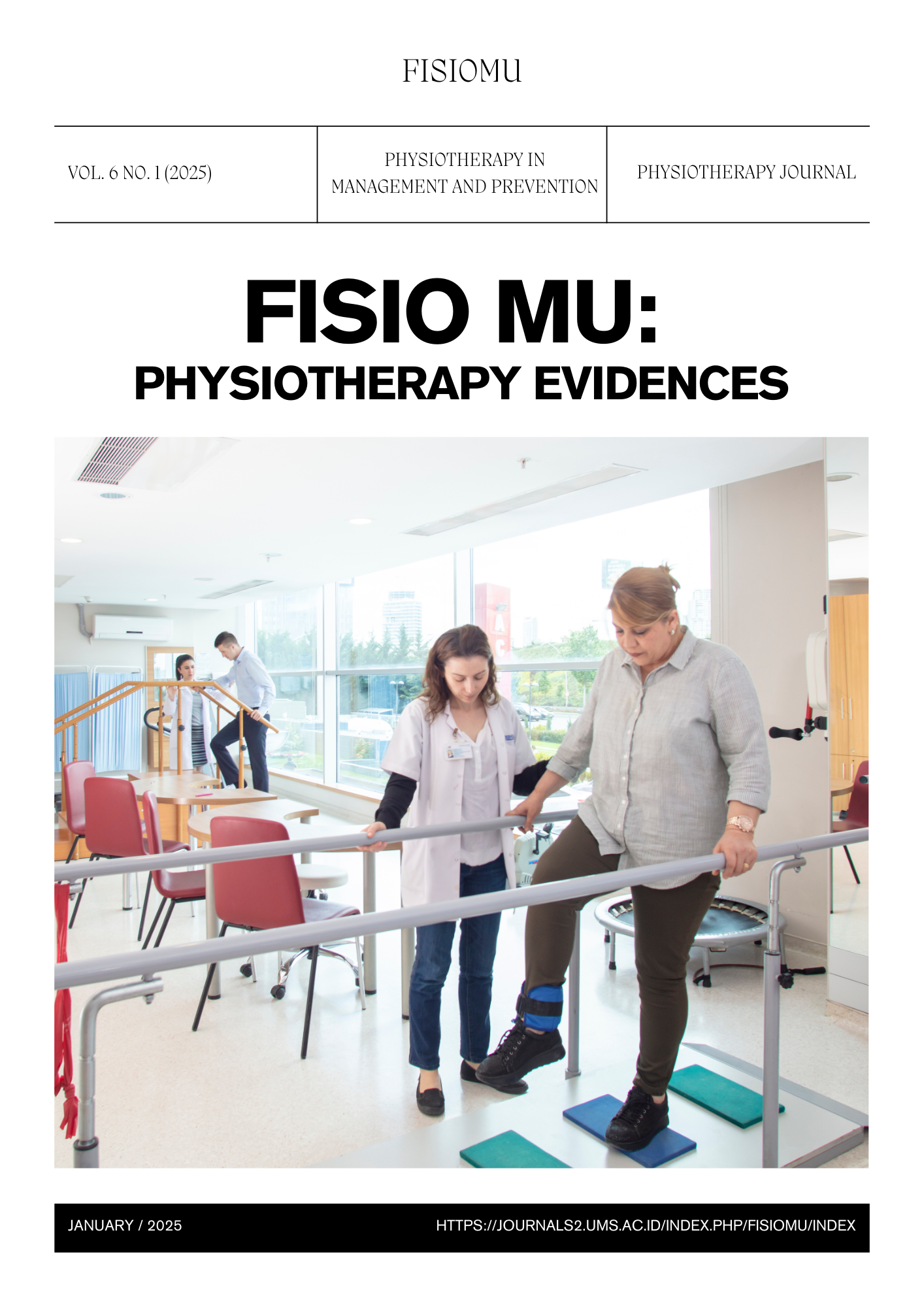Assessing Balance Recovery in Post-ACL Reconstruction Patients Using the Mini-Balance Evaluation Systems Test (Mini-BESTest)
DOI:
https://doi.org/10.23917/fisiomu.v6i1.7750Keywords:
ACL Reconstruction, Balance Recovery, Mini-BESTest, Rehabilitation AsseementAbstract
Introduction: Injuries to the anterior cruciate ligament (ACL) are some of the most prevalent musculoskeletal injuries, especially among athletes and those participating in high-impact sports or physical activities. To evaluate balance recovery in patients following Anterior Cruciate Ligament (ACL) reconstruction using the Mini-Balance Evaluation Systems Test (Mini-BESTest). Methods: This study assessed the balance abilities of post-ACL reconstruction patients by administering the Mini-BESTest. A total of 50 patients participated, completing the test at 6 months post-surgery. The results were compared to a control group of healthy individuals to determine the effectiveness of the Mini-BESTest in identifying balance deficits post-reconstruction. Results: The Mini-BESTest scores indicated significant differences in balance abilities between the post-ACL reconstruction group and the healthy control group (p<0.03). Patients demonstrated improved balance over time, but still showed deficits compared to healthy peers. Factors such as age, gender, and time since surgery were analysed for their impact on balance recovery. Conclusion: The Mini-BESTest proved to be a valuable tool for assessing balance recovery in post-ACL reconstruction patients. While improvements were noted, there remains a need for targeted rehabilitation to fully restore balance. This study highlights the utility of the Mini-BESTest in clinical settings to monitor and guide rehabilitation strategies.
Downloads
References
Bustam, I.G. (2024) ‘Pengaruh NMES dan Treadmill Exercise Terhadap Lower Extremity Functional pada Kondisi Post Operasi Rekonstruksi Anterior Cruciate Ligament’, FISIO MU: Physiotherapy Evidences, 4(1 SE-Articles), pp. 51–56. Available at: https://doi.org/10.23917/fisiomu.v4i1.5019. DOI: https://doi.org/10.23917/fisiomu.v4i1.21024
Caronni, A. et al. (2023) ‘Pay attention: you can fall! The Mini-BESTest scale and the turning duration of the TUG test provide valid balance measures in neurological patients: a prospective study with falls as the balance criterion’, Frontiers in Neurology, 14. DOI: https://doi.org/10.3389/fneur.2023.1228302
Horak, F.B., Wrisley, D.M. and Frank, J. (2009) ‘The Balance Evaluation Systems Test (BESTest) to differentiate balance deficits.’, Physical therapy, 89(5), pp. 484–498. Available at: https://doi.org/10.2522/ptj.20080071. DOI: https://doi.org/10.2522/ptj.20080071
Kochman, M., Kasprzak, M. and Kielar, A. (2022) ‘ACL Reconstruction: Which Additional Physiotherapy Interventions Improve Early-Stage Rehabilitation? A Systematic Review.’, International journal of environmental research and public health, 19(23). Available at: https://doi.org/10.3390/ijerph192315893. DOI: https://doi.org/10.3390/ijerph192315893
Löfgren, N. et al. (2014) ‘The Mini-BESTest - a clinically reproducible tool for balance evaluations in mild to moderate Parkinson¿s disease?’, BMC neurology, 14, p. 235. Available at: https://doi.org/10.1186/s12883-014-0235-7. DOI: https://doi.org/10.1186/s12883-014-0235-7
Melbourne Orthopaedic Group (2018) ‘Rehabilitation Protocol for Anterior Cruciate Ligament (ACL) Reconstruction’, Mass General Brigham, pp. 1–4.
Miyata, K. et al. (2024) ‘Structural Validity of the Mini-Balance Evaluation Systems Test in Individuals With Spinocerebellar Ataxia: A Rasch Analysis Study’, Archives of Physical Medicine and Rehabilitation, 105(4), pp. 742–749. Available at: https://doi.org/https://doi.org/10.1016/j.apmr.2023.12.015. DOI: https://doi.org/10.1016/j.apmr.2023.12.015
Opoku, M. et al. (2024) ‘Acute anterior cruciate ligament rupture: can repair become an alternative to reconstruction: a meta-analysis of randomized controlled trials and cohort studies’, Journal of Orthopaedic Surgery and Research, 19(1), p. 331. Available at: https://doi.org/10.1186/s13018-024-04812-x. DOI: https://doi.org/10.1186/s13018-024-04812-x
Piedade, S.R. et al. (2023) ‘Rehabilitation following surgical reconstruction for anterior cruciate ligament insufficiency: What has changed since the 1960s?—State of the art’, Journal of ISAKOS, 8(3), pp. 153–162. Available at: https://doi.org/https://doi.org/10.1016/j.jisako.2022.10.001. DOI: https://doi.org/10.1016/j.jisako.2022.10.001
Pinczewski, A.L. and Roe, A.J. (2018) ‘Acl rehabilitation protocol’
Downloads
Submitted
Accepted
Published
How to Cite
Issue
Section
License
Copyright (c) 2024 Fisio Mu : Physiotherapy Evidaces Journal

This work is licensed under a Creative Commons Attribution-NonCommercial-NoDerivatives 4.0 International License.

This work is licensed under a Creative Commons Attribution-NonCommercial 4.0 International License.
Authors who publish with FISIO MU: Phsiotherapy Evidences agree to the following terms:
- Author(s) retain copyright and grant the journal right of first publication with the work simultaneously licensed under a Creative Commons Attribution-NonCommercial 4.0 International License that allow others to share the work within an acknowledgement of the work’s authorship and initial publication of this journal.
- Author(s) are able to enter into separate, additional contractual arrangement for the non-exclusive distribution of the the journal’s published version of the work (e.g. acknowledgement of its initial publication in this journal).
- Author(s) are permitted and encouraged to post their work online (e.g. in institutional repositories or on their websites) prior to and during the submission process, as it can lead to productive exchanges, as well as earlier and greater citation of published works.












